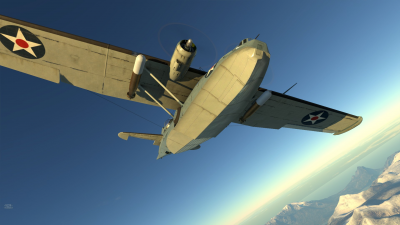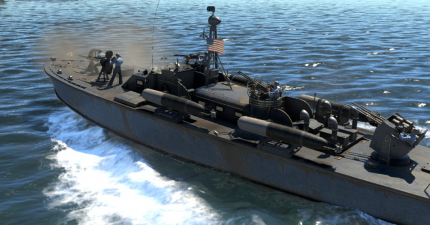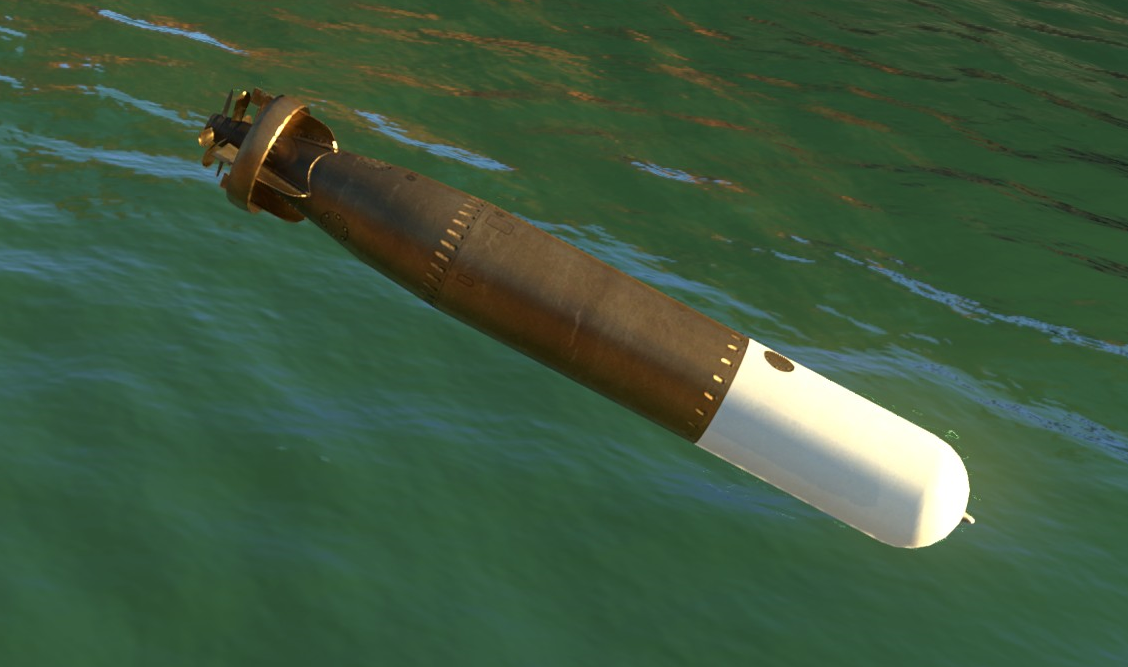Difference between revisions of "Mk.13 (569 mm)"
m (Added references.) |
m (Added images.) |
||
| Line 2: | Line 2: | ||
<div class="ttx"> | <div class="ttx"> | ||
<div class="ttx-title">22.5-inch Mk.13</div> | <div class="ttx-title">22.5-inch Mk.13</div> | ||
| − | <div class="ttx-image"> | + | <div class="ttx-image">[[File:Torpedo_Mk.13_portrait.png]]</div> |
<div class="ttx-table"> | <div class="ttx-table"> | ||
<div class="ttx-table-line ttx-table-head">Information</div> | <div class="ttx-table-line ttx-table-head">Information</div> | ||
| Line 88: | Line 88: | ||
<div><ul> | <div><ul> | ||
| − | <li style="display: inline-block;"> [[File:PBY-5a_carrying_two_Mk.13_44_torpedoes.png|thumb|none|400px|Image of a [[PBY-5a_Catalina|PBY-5a]] carrying two '''{{PAGENAME}}''' torpedoes under its wings.]] </li> | + | <li style="display: inline-block;"> [[File:PBY-5a_carrying_two_Mk.13_44_torpedoes.png|thumb|none|400px|Image of a [[PBY-5a_Catalina|PBY-5a]] carrying two '''{{PAGENAME}}''' torpedoes under its wings.]] </li> |
| − | <li style="display: inline-block;"> [[File: | + | <li style="display: inline-block;"> [[File:Torpedo_Mk.13_PT-556.png|thumb|none|430px|'''{{PAGENAME}}''' torpedoes mounted on the deck of an [[Elco_80_ft_PT-556|Elco 80 ft PT-556]].]] </li><!-- |
<li style="display: inline-block;"> [[File:Image.jpg|thumb|none|250px|Words]] </li> | <li style="display: inline-block;"> [[File:Image.jpg|thumb|none|250px|Words]] </li> | ||
<li style="display: inline-block;"> [[File:Image.jpg|thumb|none|250px|Words]] </li>--> | <li style="display: inline-block;"> [[File:Image.jpg|thumb|none|250px|Words]] </li>--> | ||
Revision as of 00:53, 24 August 2019
Contents
Description
The Mk.13 (569 mm) torpedo was a guinea pig of a torpedo having been the subject of testing and modification since 1925. Used early in World War II, this torpedo failed to operate properly approximately 70% of the time with problems of running cold (propeller mechanism failed to start), sinking, not running true (deviating path), improper depth, running on the surface or porposing (continuous jumping out of the water) due to improper water contact. Aircraft were required to fly extremely slow and low when dropping the torpedo as to not damage it on impact with the water and to provide the most stable drop possible, unfortunately, this put the torpedo bomber in a bad position of being an easy target for anti-aircraft guns mounted on enemy ships.
Extensive testing in 1942 determined that the low and slow approach to the Mk.13 launch was actually counterproductive as it caused the torpedo to “belly-flop” on the water resulting in damage sustained to its internal components. New modifications were tested which replaced fragile parts and components which were susceptible to damage upon impact with the water.[1] Updates to the torpedo allowed it to be safely dropped from a higher altitude and at faster speeds. By 1944 the Mk.13 was essentially a brand new torpedo and was accepted as the best aircraft torpedo in the U.S. inventory at that time and was credited with the sinking of the Japanese battleship Yamato.[2]
Later after World War II, there came a need for river patrol boats to be outfitted with torpedo launchers. The Mk.13 was the ideal torpedo to fulfil this need due to its short stature (compared to other torpedoes) and excelled in a shallow launch and run which afforded it to operate in shallow waters without hitting the bottom. Opportunities for sea use on smaller vessels were available in shallow areas where larger ships and torpedoes could not operate.
Vehicles equipped with this weapon
| Vehicles equipped with this weapon | |
|---|---|
| Bombers | ▄Avenger Mk II · PBY-5 Catalina · PBY-5A Catalina · ▄Catalina Mk IIIa · ▂PBY-5A Catalina · |
| SB2C-1C · SB2C-4 · ▄SB2C-5 · TBD-1 · TBF-1C | |
| Motor torpedo boats | PT-314 · PT-565 · Thunderbolt (PT-556) · PT-200 |
General info
The aircraft torpedo Mk.13 is typically carried on attack-type aircraft, however, there are a few light bombers which can also be outfitted with them. The design of the Mk.13 departed from conventional torpedo design for submarines and destroyers to accommodate being delivered by aircraft and being dropped.[2] Due to the short and stocky size of the torpedoes, they were also ideal to be outfitted on motor torpedo boats where they could either be launched from tubes or just rolled off the side of the boat for more stealthy approaches.
The appearance of this torpedo is similar to many others in that it has the appearance of a mini-submarine which contains an engine, fuel and steering devices. At almost one ton in weight, 600 lbs of it is the detachable warhead which is filled with the highly explosive Torpex.[1]
The Mk.13 torpedo was specifically designed to be used from an aerial platform with a range of 5.7 km with an in-water speed of almost 67 kph. The Mk.13 designation applies to the entire torpedo assembly as a whole, however, portions of the torpedo (warhead, gyroscope and other sub-assemblies) will have their own mark and mod designations.
Effective damage
The Mk.13 torpedo had a large high-explosive warhead compared to the Mk.VII which was frequently used at the time. The Mk.13 had a 600 lb (270 kg) Torpex (Torpedo Explosive) warhead compared the Mk.VII’s 466 lb (211 kg) warhead. Torpex was an explosive which was about 50% more powerful than TNT by mass alone as this mixture contained 40% TNT, 42% RDX and 18% powdered aluminium. While not as fast nor had as long of range as other torpedoes, the Mk.13 was used effectively at night when stealthy operations from PT boats which took place requiring torpedoes to reach the target with the least amount of warning. Aerial operations took advantage of the slower torpedo by dropping it from a higher altitude, increasing its time in the air and getting it closer to the target before it entered the water.[1]
Comparison with analogues
- Mk.13/44 : This is the same torpedo as the Mk.13 (569 mm), however, it has been outfitted with the frangible drag ring and box stabilizer to allow for higher drops at faster speeds.[1]
Usage in battles
The upgraded Mk.13 torpedo can be utilised against any target which is in the water which can include ships, boats, tanks (at the water's edge), boat-planes or even structures. Due to the higher altitude in which it can be dropped from, the delivering bomber can make a safer approach, release and get-away avoiding ship-board anti-aircraft fire and fighters patrolling around ships.
Pros and cons
Pros:
- Great run distance
- Decent max altitude for successful torpedo launch
Cons:
- Aircraft typically only carry one or two at a time
- Slow, given enough distance a ship can avoid the torpedo
- Aircraft must be low and slow for launch to ensure proper torpedo run
History
Describe the history of the creation and combat usage of the weapon in more detail than in the introduction. If the historical reference turns out to be too long, take it to a separate article, taking a link to the article about the weapon and adding a block "/ History" (example: https://wiki.warthunder.com/(Weapon-name)/History) and add a link to it here using the main template. Be sure to reference text and sources by using <ref></ref>, as well as adding them at the end of the article with <references />.
Media
-
 Image of a PBY-5a carrying two Mk.13 (569 mm) torpedoes under its wings.
Image of a PBY-5a carrying two Mk.13 (569 mm) torpedoes under its wings. -
 Mk.13 (569 mm) torpedoes mounted on the deck of an Elco 80 ft PT-556.
Mk.13 (569 mm) torpedoes mounted on the deck of an Elco 80 ft PT-556.
See also
Links to the articles on the War Thunder Wiki that you think will be useful for the reader, for example:
- reference to the article about the variant of the weapon;
- references to approximate analogues by other nations and research trees.
External links
- NavWeaps Website [World War II Torpedoes of the United States]
- Flight Journal Website [Iconic Firepower: The Outstandingly Bad Mark 13 Torpedo]
- Ordnance Pamphlet No. 629(A) [U.S. Navy Torpedoes Mark 13, B-1 & 2 July 1942]
- NAVPERS 10826 [Naval Airborne Ordnance], p. 153-166
References
- ↑ 1.0 1.1 1.2 1.3 U.S. Naval and Systems Ordnance Command. (1952). Naval Airborne Ordnance (OP 10826)
 .
.






